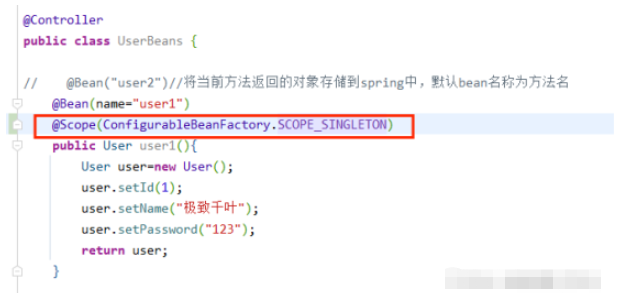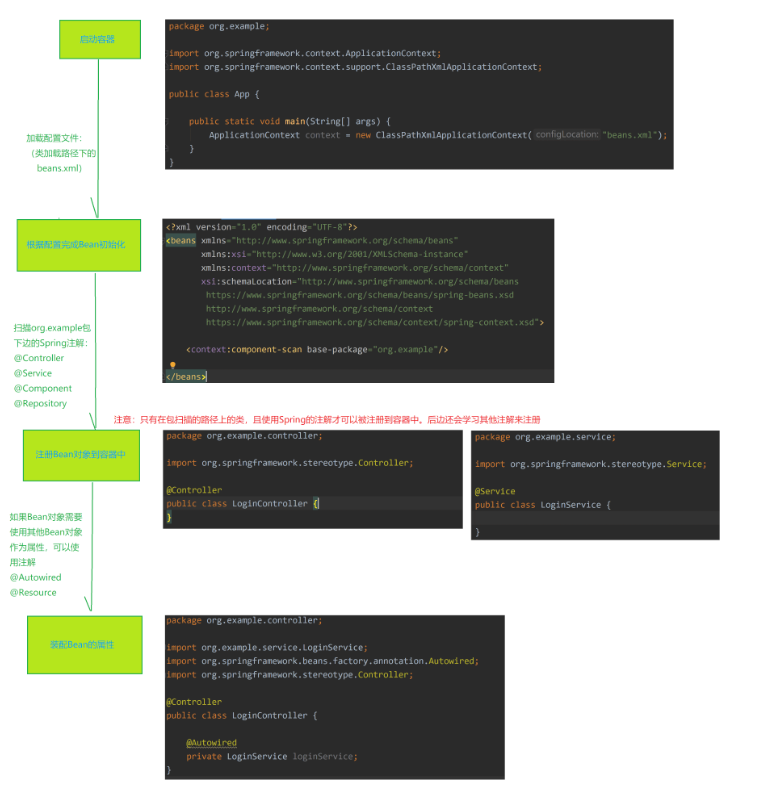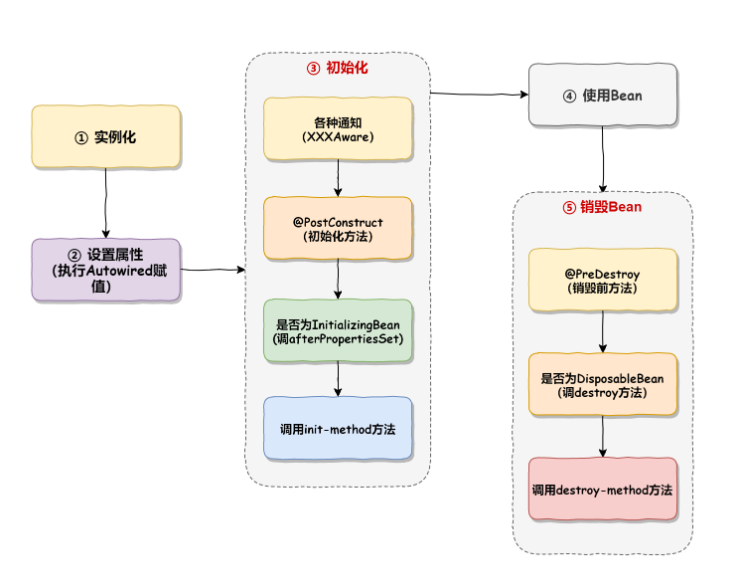您好,登錄后才能下訂單哦!
您好,登錄后才能下訂單哦!
這篇文章主要介紹“Spring Bean作用域與生命周期實例分析”的相關知識,小編通過實際案例向大家展示操作過程,操作方法簡單快捷,實用性強,希望這篇“Spring Bean作用域與生命周期實例分析”文章能幫助大家解決問題。
限定程序中變量的可用范圍叫做作用域,或者說在源代碼中定義變量的某個區域就叫做作用域。
而 Bean 的作用域是指 Bean 在 Spring 整個框架中的某種行為模式,比如 singleton 單例作用域,就表示 Bean 在整個 Spring 中只有一份,它是全局共享的,那么當其他人修改了這個值之后,那么另一個人讀取到的就是被修改的值。
Spring 容器在初始化一個 Bean 的實例時,同時會指定該實例的作用域。Spring有 6 種作用域,最后四種是基于 Spring MVC 生效的:
singleton:單例作用域(默認作用域)
prototype:原型作用域(多例作用域)
request:請求作用域
session:回話作用域
application:全局作用域
websocket:HTTP WebSocket 作用域
注意后 4 種狀態是 Spring MVC 中的值,在普通的 Spring 項目中只有前兩種。
1,2為Spring普通項目(Spring Core) 3,4,5為Spring MVC 6屬于Spring WebSocket
singleton
官方說明:(Default) Scopes a single bean definition to a single object instance for each Spring IoC container.
描述:該作用域下的Bean在IoC容器中只存在一個實例:獲取Bean(即通過applicationContext.getBean等方法獲取)及裝配Bean(即通過@Autowired注入)都是同一個對象。
場景:通常無狀態的Bean使用該作用域。無狀態表示Bean對象的屬性狀態不需要更新
備注:Spring默認選擇該作用域
prototype
官方說明:Scopes a single bean definition to any number of object instances.
描述:每次對該作用域下的Bean的請求都會創建新的實例:獲取Bean(即通過applicationContext.getBean等方法獲取)及裝配Bean(即通過@Autowired注入)都是新的對象實例。
場景:通常有狀態的Bean使用該作用域
request
官方說明:Scopes a single bean definition to the lifecycle of a single HTTP request. Thatis, each HTTP request has its own instance of a bean created off the back of a singlebean definition. Only valid in the context of a web-aware Spring ApplicationContext.
描述:每次http請求會創建新的Bean實例,類似于prototype
場景:一次http的請求和響應的共享Bean
備注:限定SpringMVC中使用
session
官方 說明:Scopes a single bean definition to the lifecycle of an HTTP Session. Only valid in the context of a web-aware Spring ApplicationContext.
描述:在一個http session中,定義一個Bean實例
場景: 用戶回話的共享Bean, 如:記錄 一個用戶的登陸信息
備注:限定SpringMVC中使用
application(了解)
官方說明:Scopes a single bean definition to the lifecycle of a ServletContext. Only valid in the context of a web-aware Spring ApplicationContext.
描述:在一個http servlet Context中,定義一個Bean實例
場景:Web應 的上下 信息, 如:記錄一個應用的共享信息
備注:限定SpringMVC中使用
websocket(了解)
官方說明:Scopes a single bean definition to the lifecycle of a WebSocket. Only valid in the context of a web-aware Spring ApplicationContext.
描述:在一個HTTP WebSocket的 命周期中,定義一個Bean實例
場景:WebSocket的每次會話中,保存了一個Map結構的頭信息,將用來包裹客戶端消息頭。第一次初始化后,直到WebSocket結束都是同一個Bean。
備注:限定Spring WebSocket中使用
singleton 是 Spring Core 的作用域;
application 是 Spring Web 中的作用域;
singleton 作 于 IoC 的容器, application 作 于 Servlet 容器。
使用@Scope標簽就可以聲明Bean的作用域,比如設置Bean的作用域
@Scope標簽可以修飾方法,也可以修飾類,@Scope有兩種設置方式:
1.直接設置值:@Scope("prototype")
2.直接枚舉設置:@Scope("ConfigurableBeanFactory.SCOPE_PROTOTYPE")


Bean 執行 流程(Spring 執 流程):啟動 Spring 容器 -> 實例化 Bean(分配內存空間,從 到有) -> Bean 注冊到 Spring 中(存操作) -> 將 Bean 裝配到需要的類中(取操作)。
所謂的生命周期指的是一個對象從誕生到銷毀的整個生命過程,我們把這個過程就叫做一個對象的生命周期。
Bean 的生命周期分為以下 5 部分:
實例化 Bean(為 Bean 分配內存空間)【實例化!=初始化;只是執行分配內存空間的功能】
設置屬性(Bean 注入和裝配)【執行依賴類的注入A需要使用B的方法,先初始化并將B加載到當前類】
Bean 初始化
實現了各種Aware 通知的方法,如BeanNameAware、BeanFactoryAware、ApplicationContextAware 的接口方法;
執行BeanPostProcessor 初始化前置方法;
執行@PostConstruct初始化方法,依賴注入操作之后被執行;
執行指定的 init-method方法(如果有指定的話);
執行BeanPostProcessor 初始化后置方法。
使用Bean
銷毀 Bean
銷毀容器的各種 法,如 @PreDestroy、DisposableBean 接口方法、destroy-method。
執行流程如下圖所示:

實例化和初始化的區別
實例化和屬性設置是 Java 級別的系統“事件”,其操作過程不可人工干預和修改;而初始化是給開發者提供的,可以在實例化之后,類加載完成之前進行自定義“事件”處理。
生命流程的“故事”
Bean 的生命流程看似繁瑣,但咱們可以以生活中的場景來理解它,比如我們現在需要買一棟房子,那么我們的流程是這樣的:
先買房(實例化,從無到有);
裝修(設置屬性);
買家電,如洗衣機、冰箱、電視、空調等([各種]初始化);
入住(使用 Bean);
賣出去(Bean 銷毀)。
生命周期演示:
package com.beans;
import org.springframework.beans.factory.BeanNameAware;
import javax.annotation.PostConstruct;
import javax.annotation.PreDestroy;
public class BeanLifeComponent implements BeanNameAware {
@PostConstruct
public void postConstruct() {
System.out.println("執行 PostConstruct()");
}
public void init() {
System.out.println("執行 BeanLifeComponent init-method");
}
public void destory() {
System.out.println("執行了 destory 方法");
}
@PreDestroy
public void preDestroy() {
System.out.println("執行:preDestroy()");
}
public void setBeanName(String s) {
System.out.println("執行了 setBeanName 方法:" + s);
}
}xml 配置如下:
<?xml version="1.0" encoding="UTF-8"?> <beans xmlns="http://www.springframework.org/schema/beans" xmlns:xsi="http://www.w3.org/2001/XMLSchema-instance" xmlns:content="http://www.springframework.org/schema/context" xsi:schemaLocation="http://www.springframework.org/schema/beans http://www.springframework.org/schema/beans/spring-beans.xsd http://www.springframework.org/schema/context https://www.springframework.org/schema/context/spring-context.xsd"> <!-- 設置需要存儲到 spring 中的 bean 根目錄 --> <content:component-scan base-package="com.beans"></content:component-scan> <bean id="beanlife" class="com.beans.BeanLifeComponent" init-method="init" destroy-method="destory"></bean> </beans>
調用類:
package com;
import com.beans.BeanLifeComponent;
import org.springframework.context.support.ClassPathXmlApplicationContext;
public class App2 {
public static void main(String[] args) {
ClassPathXmlApplicationContext context =
new ClassPathXmlApplicationContext("spring-config.xml");
BeanLifeComponent beanLifeComponent = context.getBean(BeanLifeComponent.class);
System.out.println("執行銷毀方法");
beanLifeComponent.destory(); // 執行銷毀方法
}
}關于“Spring Bean作用域與生命周期實例分析”的內容就介紹到這里了,感謝大家的閱讀。如果想了解更多行業相關的知識,可以關注億速云行業資訊頻道,小編每天都會為大家更新不同的知識點。
免責聲明:本站發布的內容(圖片、視頻和文字)以原創、轉載和分享為主,文章觀點不代表本網站立場,如果涉及侵權請聯系站長郵箱:is@yisu.com進行舉報,并提供相關證據,一經查實,將立刻刪除涉嫌侵權內容。